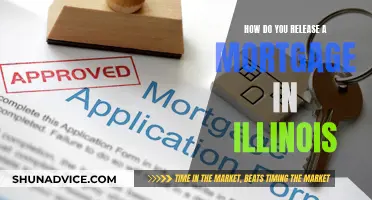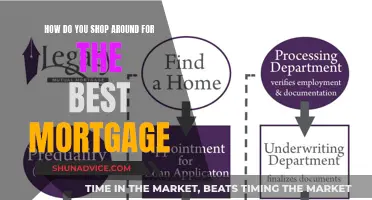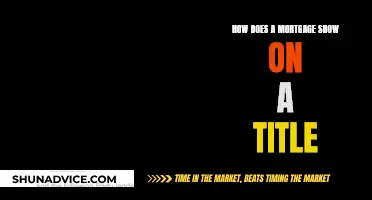
Bankruptcy is a viable option for those facing an upside-down mortgage, where the value of a home is less than the homeowner's outstanding mortgage debt. This situation can arise due to fluctuations in the housing market or unadvisable loan terms. While bankruptcy should be a last resort, it can provide relief by discharging outstanding mortgage debt or allowing homeowners to remain in their homes by stripping junior liens or repaying missed payments over time. Chapter 7 bankruptcy, or total bankruptcy, involves liquidating assets to pay off debts, while Chapter 13 bankruptcy offers a repayment plan without the need to sell property. Bankruptcy will negatively impact credit scores and remain on credit reports for 7-10 years, making it crucial to explore other options first, such as refinancing or negotiating with lenders for temporary relief.
How does bankruptcy help an upside-down mortgage?
| Characteristics | Values |
|---|---|
| Definition of an upside-down mortgage | When the value of a home is less than the homeowner's outstanding mortgage debt |
| Other names | Underwater mortgage |
| Causes | Fluctuations in the local or national housing market; bad loans with high interest rates, fluctuating interest rates, or an unadvisable amount of risk |
| Bankruptcy options | Chapter 7 (total bankruptcy); Chapter 13 (repayment plan) |
| Chapter 7 bankruptcy | Also known as "straight" or "liquidation" bankruptcy; wipes out most or all debt but requires liquidation of assets and not everyone qualifies |
| Chapter 13 bankruptcy | Filing a plan with the bankruptcy court to repay creditors; can be used to eliminate second or third mortgages |
| Impact on credit score | A bankruptcy stays on your credit report for 7-10 years and can lower your score by up to 200 points |
| Other considerations | Bankruptcy is a last resort; consider working with lenders and creditors to find temporary relief options or graceful exit strategies |
What You'll Learn
- Bankruptcy can help discharge mortgage debt and strip junior liens from property
- Chapter 7 bankruptcy forgives debts but requires liquidation of assets
- Chapter 13 bankruptcy cancels second/third mortgages and allows repayment plans
- Bankruptcy severely impacts credit scores and remains on credit reports for 7-10 years
- Lenders scrutinise bankruptcy filings and may offer temporary relief options

Bankruptcy can help discharge mortgage debt and strip junior liens from property
Bankruptcy is a powerful tool that can help individuals manage overwhelming debt, including mortgage debt. While it should be considered a last resort due to the potential loss of assets and severe credit impact, bankruptcy can provide a path to financial relief for those struggling with an upside-down mortgage.
An upside-down mortgage occurs when the value of a homeowner's property is less than their outstanding mortgage debt. This situation can arise due to fluctuations in the housing market or taking on a bad loan with unfavourable terms. Regardless of the cause, it leaves homeowners with difficult choices.
Chapter 7 bankruptcy, also known as total bankruptcy, involves liquidating assets to repay debts. While it can eliminate much of the outstanding debt, individuals may be forced to sell properties, including their primary residence, to satisfy creditors. Chapter 7 does not allow for the removal of voluntary or statutory liens, only judgment liens, and it is not applicable to real estate.
On the other hand, Chapter 13 bankruptcy is a repayment plan that allows individuals to retain their assets while restructuring debt repayment. Importantly, Chapter 13 provides a mechanism for lien stripping, which can help reduce monthly mortgage payments. Lien stripping allows homeowners to remove junior liens, such as second or third mortgages, from their property. By converting these secured debts into unsecured debts, similar to credit card debts, the overall debt burden is reduced, making it easier for individuals to manage their mortgage payments.
It is important to note that bankruptcy will likely have a significant negative impact on an individual's credit score and may affect their ability to obtain favourable mortgage rates in the future. However, for those struggling with an upside-down mortgage, bankruptcy can provide a means to discharge some mortgage debt and strip junior liens, offering a path towards financial stability.
Understanding Mortgage Repayments: Strategies for Reducing Debt
You may want to see also

Chapter 7 bankruptcy forgives debts but requires liquidation of assets
An upside-down mortgage is when the value of a home is less than the homeowner's outstanding mortgage debt. This can be caused by a fluctuation in the housing market or a bad loan. If you find yourself in this situation, bankruptcy can be an option to help you obtain a discharge of the outstanding mortgage debt.
Chapter 7 bankruptcy, also known as total bankruptcy, can be a way to wipe out much or all of your outstanding debt. However, it requires the liquidation of non-exempt assets to pay off creditors. This means that you may be forced to sell some of your property to pay back your debts. The bankruptcy court will appoint a trustee to oversee the process, who will review your assets and determine which can be liquidated. The trustee will then sell these assets and use the proceeds to pay off your creditors.
To qualify for Chapter 7 bankruptcy, you must meet income limits or pass a means test. Additionally, you must complete a credit counselling course from an approved agency within 180 days before filing. This course helps individuals understand their financial situation and explore alternatives to bankruptcy. It is important to note that bankruptcy will have a severe impact on your credit score, and it should be considered a last resort.
If you are facing an upside-down mortgage, it is advisable to work with your lenders and creditors to see if they can provide temporary relief options. They may be able to offer a payment reduction, relief for a period of time, repayment plans, or loan modifications. However, if bankruptcy becomes your only option, Chapter 7 can provide a fresh start by forgiving your debts in exchange for the liquidation of some of your assets.
Mortgage Officers: Strategies for Finding Quality Leads
You may want to see also

Chapter 13 bankruptcy cancels second/third mortgages and allows repayment plans
Chapter 13 bankruptcy is also known as a wage earner's plan. It allows individuals with regular income to develop a plan to repay all or part of their debts. Under this chapter, debtors propose a repayment plan to make instalments to creditors over three to five years. If the debtor's current monthly income is less than the applicable state median, the plan will be for three years unless the court approves a longer period. If the debtor's current monthly income is greater than the applicable state median, the plan generally must be for five years. During this time, the law forbids creditors from starting or continuing collection efforts.
Chapter 13 bankruptcy can help you save your house. If you satisfy certain conditions, you might be able to remove a wholly unsecured junior lien (such as a second mortgage) through lien stripping or reduce the outstanding balance of other secured debts (such as a car loan) with a Chapter 13 cramdown. If you strip a junior lien from your house, it will be classified as a nonpriority unsecured debt in your bankruptcy and eliminated when you receive your discharge. When you cram down a car loan or other secured debt, the loan is split into secured and unsecured portions. You must pay off the secured portion through your repayment plan. However, the unsecured part is wiped out when you complete your plan and obtain a discharge.
A significant benefit of Chapter 13 is that in some instances, you can pay significantly less for your home than what you owe. If you have junior mortgages or a home equity line of credit (HELOC) that are no longer secured by the equity in your home, you can strip these loans off through Chapter 13 bankruptcy. Before removing or stripping down a junior mortgage or HELOC, the value of your home must have declined enough so that your home equity is insufficient to cover any portion of the loan or HELOC.
If you are in foreclosure when you file for Chapter 13, bankruptcy's automatic stay—the order that stops most creditors in their tracks—puts a hold on the foreclosure. If you stay current on your mortgage payments and make up the arrears through your Chapter 13 plan—and you can afford to pay for any non-exempt equity—the lender can't foreclose. You'll be able to keep your home.
Understanding Mortgage Wraps: A Guide to Property Finance
You may want to see also

Bankruptcy severely impacts credit scores and remains on credit reports for 7-10 years
Bankruptcy is a complex process that can help individuals manage unpayable debts. While it may be the best financial decision in certain circumstances, it's important to carefully consider the negative consequences it can have on your credit score and financial situation.
When you file for bankruptcy, it indicates that you can no longer pay your debts as originally agreed. This information is recorded on your credit report and can remain there for up to 7-10 years, depending on the type of bankruptcy. During this time, your credit score will be negatively impacted, and you may face challenges in obtaining new credit or loans, including mortgages. The exact impact on your credit score will depend on your credit history, the events leading up to the bankruptcy, and your overall credit history.
Chapter 7 bankruptcy, also known as total or liquidation bankruptcy, involves selling or liquidating assets to pay off debts. This type of bankruptcy will stay on your credit report for 10 years and can result in a significant drop in your credit score. Chapter 13 bankruptcy, on the other hand, is a repayment plan that allows borrowers to restructure their debt and create a new repayment plan. It remains on your credit report for seven years and may have a less severe impact on your credit score.
The negative consequences of bankruptcy on your credit score can lead to higher interest rates when securing new credit and a smaller pool of creditors willing to work with you. It's important to consult with a credit counselor or bankruptcy attorney before filing to understand the long-term consequences and explore alternative options for debt relief.
While bankruptcy can have severe impacts on your credit score and financial situation, it also provides an opportunity for a "second chance" to manage your finances and rebuild your credit history over time.
Understanding Your Mortgage Statement: A Visual Guide
You may want to see also

Lenders scrutinise bankruptcy filings and may offer temporary relief options
Bankruptcy is a last resort option that can have a severe impact on your credit score and may result in the loss of assets. It is recommended to work with lenders and creditors to explore temporary relief options. Lenders will scrutinise bankruptcy filings and an individual's credit history, and the impact of bankruptcy on their credit score. The higher the credit score, the more negative the impact of bankruptcy. A bankruptcy stays on a credit report for 7-10 years, and during this period, it becomes harder to get approved for credit.
Lenders will always review documentation to ensure the borrower can afford their mortgage, and bankruptcy filings will be subject to extra scrutiny. Lenders may offer temporary relief options, such as payment reductions or relief for a period, repayment plans, payment deferrals, or loan modifications to add past-due payments to the loan balance.
Chapter 7 bankruptcy, also known as total bankruptcy, wipes out or discharges debts through liquidation or selling assets. Chapter 13 bankruptcy is a repayment plan where the borrower files a plan to repay creditors based on what they can afford. It is important to understand the terms and conditions of bankruptcy and loan types, as well as seek expert advice, before making any decisions.
Arizona's Mortgage Definition: What You Need to Know
You may want to see also
Frequently asked questions
An upside-down mortgage is when the value of a home is less than the homeowner's outstanding mortgage debt. This is also referred to as an underwater mortgage.
Bankruptcy can help eliminate a second or third mortgage. Chapter 13 bankruptcy, in particular, allows for the cancellation of a second or third mortgage. It also offers a repayment plan and is less like a total wipeout.
Chapter 7 bankruptcy is also known as total bankruptcy, where most or all of the outstanding debt is wiped out. However, you may be forced to sell or liquidate some of your property. Chapter 13 bankruptcy, on the other hand, is a repayment plan where the borrower files a plan with the bankruptcy court to repay creditors over time.
Bankruptcy should be considered a last resort due to the potential loss of assets and the severe negative impact on your credit score. It is recommended to work with lenders and creditors to explore options for temporary relief.
Alternatives include working with your servicer to explore options such as payment reduction, relief, repayment plans, payment deferrals, or loan modifications.







